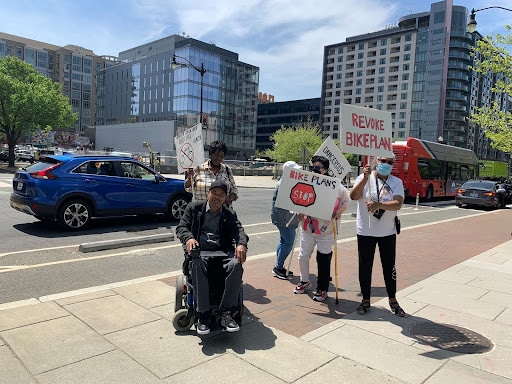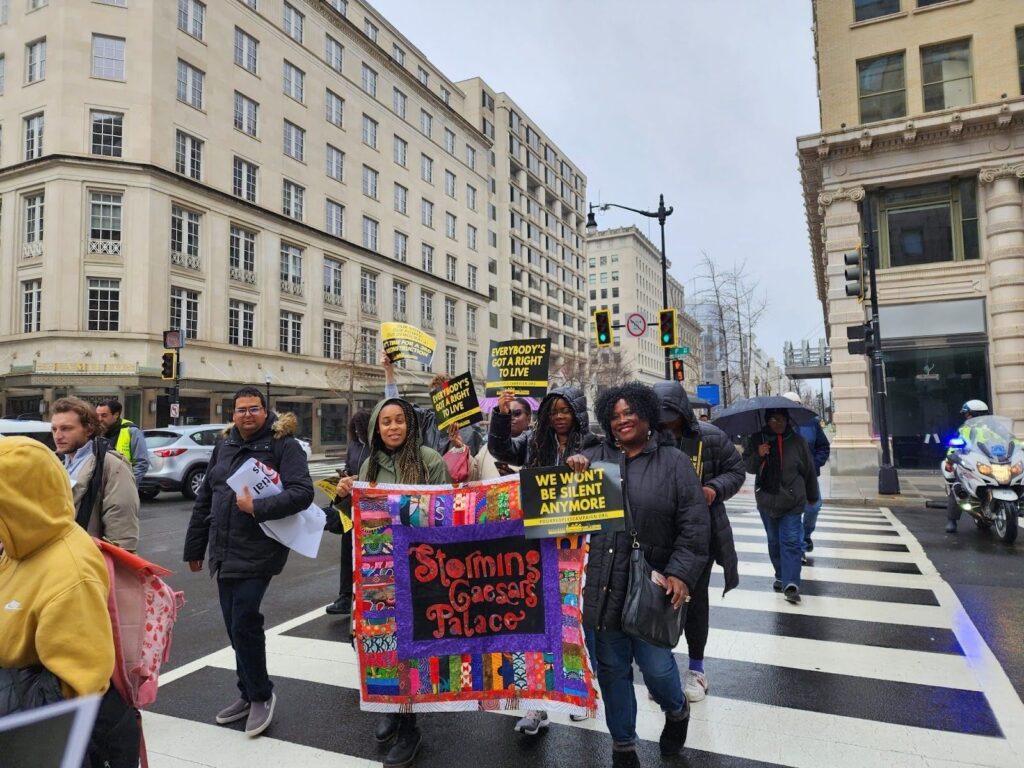Ever since he was shot during a robbery in 1977, Kevin Rodgers has been in a wheelchair. But Rodgers, a four-term Advisory Neighborhood Commission member who is up for reelection this year, said his handicap has never stopped him from getting to work.
Rodgers has kept that fighting spirit over the years. On April 21, he organized a protest against protected bike lanes on K Street NW, where he lives. In a press release, Rodgers expressed concern for how protected bike lanes, which include a physical barrier between motor vehicle traffic and bicyclists, would impact “low-income Black residents who are largely senior and many handicapped.”
The installation of new bike lanes have historically been a flashpoint in D.C. Some scholars of gentrification have argued that in certain U.S. cities, the construction of bike lanes have been an outward sign of gentrification through urban planning.
Advocates for bike lanes have acknowledged that new bicycling infrastructure is often built in wealthier, white neighborhoods. One solution proposed by advocates is to build a connected and protected bike lane network that would expand bike lanes beyond the communities they currently exist in.
As part of its outreach efforts to make cycling a more inclusive activity across the District, the Washington Area Bicycling Association (WABA) has hosted workshops in communities with lower rates of cycling that communicate the physical and economic benefits of riding a bike. It also holds bicycling classes for adults and group rides for new learners.
The April 21 protest organized by Rodgers reinvigorated the debate about protected bike lanes in D.C. For Rodgers and other protesters with disabilities, concerns about personal safety were dominant, as well as claims that bike lanes reduce parking spaces. But cycling advocates insist that bike lanes make the streets safer for everyone, are better for the climate and carry economic benefits for local businesses.
“The bikes move too fast for anyone to step out their door and get a cab, Uber or MetroAccess bus,” Rodgers said at the protest.
Just a few days before the protest, Rodgers said, he was nearly hit by a bicyclist while trying to catch a bus at K Street and New Jersey Ave. The cyclist didn’t apologize, he said.
Rodgers demands that the District Department of Transportation (DDOT) conduct a full impact report on bike lanes in D.C. and the safety risks they carry for pedestrians.

Sarah Roberts, who also attended the protest, lives in an apartment building on K Street NW. In December 2021, the 67 year old resident suffered a bad fall that resulted in a broken kneecap and ankle, as well as injuries to her spinal chord.
She says bike lanes are a hazard to pedestrians just trying to go about their day — especially for those in wheelchairs.
A month ago, as Roberts left her apartment building with her two grandchildren, a bicyclist she described as “flying” toward them nearly ran them over, she said.

In early 2023, the city plans to install dedicated bus lanes on K St. NW that would physically separate bus routes from other vehicle traffic. These protected bus lanes would eliminate the need for bus riders such as Roberts and Rodgers to cross bike lanes when getting on or off buses, reducing the likelihood of the near-collisions with cyclists they described.
“There’s gonna be bad seeds in any population,” Rachel Maisler, chair of the D.C. Bicycle Advisory Council, said in an interview. “The vast majority (of cyclists) are gonna look out for you, and slow down,” she said.
An avid cyclist herself, Maisler is a passionate advocate for protected bike lanes.
“Everyone is entitled to their opinions, but research shows that bike lanes make the city safer for all road users,” she said.
For instance, bike lanes create a buffer between drivers and pedestrians on the sidewalk, she said. And by making travel lanes narrower, bike lanes slow down drivers.
In a 2019 study, researchers at the University of Colorado Denver and the University of New Mexico found protected bike lanes lead to “fewer fatalities and better road-safety outcomes for all road users,” including drivers and pedestrians. Researchers reached the conclusion after analyzing 13 years of data from 12 large U.S. cities.
In addition to making roads safer for everyone, protected bike lanes benefit cities in numerous other ways. For instance, they can provide a boost to the local economy. Having protected bike lanes in commercial corridors brings more traffic to the retailers and the restaurants in those areas, Maisler said.
When protected bike lanes are built, they also lead to more people cycling around the city as opposed to other modes of transportation. And more people riding bikes reduces motor vehicle traffic, carbon emissions and noise pollution.
806 cyclists died in motor-vehicle crashes in the U.S. in 2020, according to the National Safety Council. Numbers for 2021 have yet to be released. Over the past decade, American roads have gotten deadlier for pedestrians and cyclists, according to data from National Highway Traffic Safety Administration.
Maisler herself has been involved in two motor vehicle accidents while riding her bike around D.C.
“I’m one of the lucky ones,” she said.
One time, Maisler stopped at a crosswalk in front of the Jefferson memorial, her hand pointing out to make a left turn onto a trail. The driver behind her drove right into her ankle. Another time, when an Uber abruptly stopped mid-block, the disembarking passenger slammed open her door into Maisler’s wrist. Sustaining a torn ligament, Maisler had to go to physical therapy for ten months. Even now, she said only has about 80% strength back in her injured hand.
DDOT first introduced protected bike lanes to the city in 2009. Protected bike lanes are considered safer for cyclists than regular bike lanes, which divide cyclists from traffic using just painted markers. DDOT says “protected bike lanes significantly improve the safety of bicyclists and increase safety for pedestrians and drivers.”
In 2020, DDOT announced a plan to install an additional 20 miles of protected bike lanes over the course of three years, citing an increased demand for safer cycling infrastructure. And Mayor Muriel Bowser’s fiscal year 2023 budget proposal allocates $36 million towards the addition of 10 miles of protected bike lanes per year for the next six years. Throughout the years bike-lane advocates criticized the city’s progress on the plan as being too slow.
Another issue that he raised at the April 21 protest was how the installation of bike lanes on K Street has reduced parking space for residents.
There are at least 1,500 miles of on-street car parking in Washington, D.C., according to the Parking Reform Network (PFN), a nonprofit that analyzes the impact of parking policies on climate change and equity. With 24 miles of protected bike lanes currently in D.C, the organization said that at most, 1.6% of the city’s on-street car parking has been repurposed for protected bike lanes.

Still, in some areas, people with disabilities attending the protest who live in densely populated areas such as the K St NW corridor said they are having an increasingly hard time finding parking.
“People now have to go halfway around the block, or even a mile away from their home, just to get a parking spot,” Rodgers said.
Correction (05.19.2022)
A previous version of this article incorrectly attributed the quote, “People now have to go halfway around the block, or even a mile away from their home, just to get a parking spot,” to Rachel Maisler. The correct author of the quote is Kevin Rodgers.








